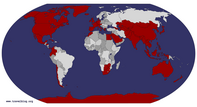Advertisement
Published: October 10th 2012

 Colorful bus
Colorful bus
many seen along the roadsWe managed to get out of Kathmandu finally (more on that in later blog) a week ago and have since traveled among the farmlands, countryside and jungles of Nepal. Today we drove up into the mountains and are enjoying the slightly cooler weather. The intent of this blog is to begin to tell you about some of the things we have seen on our drive and the observations we’ve made and the impressions we have been left with while traveling in this beautiful, yet poor nation.
We would first ask for some forgiveness for some of the photos, as most are snapshots taken from a moving vehicle as we moved about the country. Anyone who has attempted to stick a camera out of a moving vehicle on a bad road can testify that the quality of the photo can sometimes leave something to be desired. Few of them were taken with care so they are tad off center and a few may offer a bit of a blur. But, the underlying hope is that they will give you a taste of all we have seen along the way. These are the things that draw people to explore Nepal.
The
people of Nepal are so very kind and friendly. From what we can tell they are very honest and hard working.
We’ve traveled off the beaten path today to an area that a limited number of tourists and visitors travel. This area is said to be a short cut to Pokhara from the Indian border or from Lumbini. One of the first things we enjoyed was the lower temperature reading. The cool air is a welcome change from the heat in Chitwan and Lumbini. Certainly we would have adjusted to the heat and humidity if we have stayed longer, but our few days did not allow for that. Now we only mildly perspire as opposed to melting after a short hike.
One of the first things that strike you is that Nepal is similar to other Asian countries in that the roads and transportation are irregular. Easy to put in one sentence, but the meaning is fairly clear. There are many public buses available within Nepal that will take you wherever you travel. All you have to do is get on a bus that is likely crowded, dusty and not air-conditioned. There are a few that are air-conditioned,
but most are not. However, some have audio music (and also the dreaded videos). Some buses and transport trucks are colorfully decorated. They use multi- colored paints and streamers to adorn their vehicles. Just imagine a Greyhound bus in the U.S. painted in bright colors of the spectrum with some streamers thrown in just for some glitter.
Although fairly mountainous, Nepal has rich farmlands where rice, hay, mangos and bananas are grown. They will stick some rice anywhere they can grow it and in the mountain passes you sometimes glance over and see some terracing of the rice fields, which is pleasing to the eye. The rivers are low this time of year and a few riverbeds we’ve seen have been dry. In a few months that will change again when the rains return and there is run off from the mountains. We’ve seen many children playing in the rivers, men fishing and families bathing. The oxen and water buffalo seem to have taken a liking to the cooler waters as well.
Each town and village we pass seems alive with activity. The Nepali people seem to be always on the move, whether by motorbike, bicycle, cart, wagon,

 Wrecked truck
Wrecked truck
broken axel in ditchtractor or simply on foot. We find the Nepali people very industrious. They seem to be working all the time. In each village is a central water source that becomes a town meeting place. All the women bring their laundry to wash. (Which can resemble taking your clothes and literally beating them on a rock. They are laughing and having a good time. Certainly, they must be talking about all the men as they do their work. Most appear to like to wear clean clothing, with some women wearing some very bright and pleasant colors. Once the laundry is completed they use the same public water source for a shower. No shyness here. It has become very ordinary to see partially naked locals bathing together and we barely notice it anymore. When you don’t have indoor plumbing, this is what you do.
For us, the thing that is the most foreign is the roadways and traffic patterns. To us the issues seem more intense, dangerous or treacherous ….pick your adjective and insert here. …any way more intense than any other Asian country we have traveled to so far. The locals show absolutely no fear on their faces, as this

 Broken Axel
Broken Axel
and no auto club to callis their norm. To us it is unusual to experience the chaos of their roads. The Nepali people drive with abandon. Reminding you that to us these roads are a bit narrow for two-way traffic but it is the standard here. Along with vehicles moving in two directions are motorbikes weaving in and out of traffic, never caring which lane (or lack of lane they are in). Not to mention pedestrians along with edges. It is not uncommon to come around a corner on a narrow mountain road and find a large bus stopped in the middle of the road. One simply navigates around the stopped vehicle and goes on. There is an occasional cow sitting in the middle of the road, or a woman pulling her two oxen on a rope—this can get your attention but no need to slow down. Just part of daily life here.
As in other Asian countries drivers use a series of honks and beeps to signal they are coming around a blind corner. This form of communication serves everyone well and seems like an Asian Morse Code. Another beep can be heard when you are being overtaken by a vehicle or scooter.

 Heavy work
Heavy work
gathering feed for the goatsIt's kind of like a reminder that someone is going to pass. In Nepal, when you are passing someone and the oncoming vehicle flashes lights at you it means they are in a hurry (....and you should get out of the way!)
It is not uncommon to find a goat herder with a dozen or so goats walking on the highway…..and the fast moving buses have no trouble negotiating around them.
Often we see three people riding a motorbike with the woman in the back riding sidesaddle and holding her parasol without a worry in the world. We've seen a mix of traditional local clothing and more modern jeans and tee shirts. We are always amazed to see people wearing long pants and long sleeve shirts in these temperatures.
As we started out this morning heading for the mountains we were told our highway was dangerous and commonly had land and rock slides. Oh crap, this must be bad if we are being given warning because several days ago we traveled a mountain road between Kathmandu and Chitwan that was full of potholes and craters and nothing was mentioned. Many of the roads would not be called

 Baby playing in the street
Baby playing in the street
found her crawling up the roadroads by our standards but dirt and gravel paths—hanging on to the edge of a cliff. Travel here is challenging at best and full of anxiety-producing moments. But after a few days, it doesn’t seem quite as bad, until of course the next near miss.
Going the road less traveled can get your heart pumping. We’d be driving on a paved road and then all of a sudden as we climbed the mountain it turned to sand and gravel. Indeed we did see several recently fallen rocks….and boulders. At one point a young man was trying to clear the road for vehicles. These small roads are filled with large buses and trucks moving far faster than necessary. They show no fear as a bus passes another bus around the curvy roads. As one negotiates these kinds of roads you cannot help but think about Karma (since we’ve just been to the birthplace of Buddha). From time to time our road would become one lane and traffic would slow…… Observation tells us that the most confident driver goes next—it didn’t seem to have anything to do with taking turns. The bigger vehicle usually wins and if you snooze, you lose.
We arrived in Tanzen in the afternoon and did a walk about around town. It is a small mountain village of about 35,000 with some spectacular scenery. In a couple of hours you can see the Vishnu Temple, Bhagawati Temple, the Tanzen Durbar palace from the 20
th century, which features a large doorway that allowed people to enter on their elephants. One of the things we most enjoyed was watching the children swimming and playing in the public swimming pool. It was a Saturday, and this is the day of the week when most shops are closed and the locals were hanging out around town.
The mountain views from our hotel were stunning. You walk out of your room and boom……24,000 ft. peaks just staring at you. Look the other way and the valley below is in a haze, all the while a nice cooling breeze blows. Nice…..
We find the Nepali people very attractive. They have nice cheekbones and beautiful smooth brown skin. They smile a lot and don’t mind having their pictures taken for the most part. Everyone has been kind and interested in knowing more about us and where we are from. This particular
town gets very few foreign guests, and they were looking at us as kind of a novelty, especially with our sunglasses on.
From our perspective life in Nepal looks hard but this is their norm so don’t imagine they feel like it is a hard life. We’ve learned that schoolteachers make about 9,000 rupees a month, which is about $108. The military is voluntary and they earn about 10,000 rupees a month, which is about $120. We were told you join the military for life but suspect they meant they could stay in for life rather than having to stay in for life. If any one knows for sure, let us know the rules.
Here are some prices for important Nepali purchases:
A goat cost 20,000 rupees or $ 240.
A milking goat cost 35,000 rupees or $ 420.
An ox is 50,000 rupees or $ 600.
Water buffalo cost 50,000 and is used for both milk and the meat.
They recycle in Nepal. (
maybe not enough----but)
A kilo (2.2 pounds) of plastic bottles pays 25 rupees or .29 cents.
A kilo of newspaper pays 40 rupees or .47 cents.
Well, those are a few observations of a country where wealth is not measured by the amount of rupees in your pocket, but more likely by a sense of happiness due to the beautiful eye-catching surroundings and the friendliness or neighbors.
Places we stayed: Hotel Srinager
Advertisement
Tot: 0.088s; Tpl: 0.018s; cc: 14; qc: 37; dbt: 0.0346s; 1; m:domysql w:travelblog (10.17.0.13); sld: 1;
; mem: 1.2mb





























RENanDREW
Ren & Andrew
love this photo :)